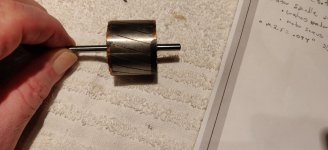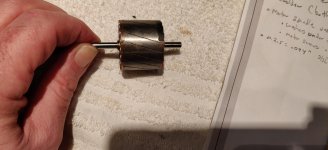For what it's worth I found HanzaHiFi's Springs for the motor to be a significant upgrade. It also the need for new "rubbers" in the motor suspension at a later date. They were also remarkably inexpensive.
Thanks his047....so good motor springs...and the deck can be fastened to plinth without the mushrooms!!?
I'm noticing a 2mm end-float in the motor shaft...
Struggling here....hoping to find an image....and dims if possible....of Thrust bearing plate, which is part of the MOTOR assembly (lower bearing)....?
Can this be homemade...and if so, which materials can be used?
Struggling here....hoping to find an image....and dims if possible....of Thrust bearing plate, which is part of the MOTOR assembly (lower bearing)....?
Can this be homemade...and if so, which materials can be used?
Last edited:
You can make a round delrin pad. 2mm is about right amount of vertical play. You can turn over the original. I still recommend replacing the bushings. Kit comes with thrust pad, felts, sintered bushings and new rivets.
...it's Delrin...thanks.....but great if 2mm is OK!!
If the deck was mine....I wouldn't think twice about spending on decent upgrades, but the last time the owner actually 'spent' was in '91....and I know he just isn't up for it himself!
Hello ralphfcooke! Thanks for the feedback and advice. I agree with you that this is one of the best PAPST motors. My humble experience and a series of experiments have made a choice in favor of this motor. Indeed, my experiments showed some difficulties with the rotation of the PAPST motor, however, at the moment I am working with drMordor on a speed controller project for this type of motors.
Today the motor looks like this:







Today the motor looks like this:







Hi Denstyle,
You've got one of the very best Papst motors there! Unfortunately it's not the best to use in conjunction with the td124, unless you also use something like the SG4 speed controller. Your Papst is one of the synchronous ones, which means that the eddy current mechanism is of very little or no use.
Papst outer rotor motors come in different designs, depending on the magnetic characteristics of the steel used in the rotor. The one Papst made specifically for Thorens used quite a 'soft' steel, allowing for a 'close to, but not quite' synchronous motor that works in conjunction with the eddy current mechanism.
I have around 20 Papst outer rotor motors, around half are synchronous, the rest differ in the closeness to synchronous they achieve.
Hello All,
I recently had my TD-124 restored (it is an early model, probably from 1959).
I have a few questions I was wondering if you could help with, and would be most grateful for any advice.
1. How often should I lubricate the motor? Schopper AG said "not more than once per year, only 1-2 drops for each bushing. It's been about a year since I got it back.
2. Can someone please walk me through how to lubricate the E-50 motor?
I know there are the top and lower bushings, and the top one is reached by taking off the motor pulley, but am unsure how to correctly remove and reinstall it.
For the lower bushing, my motor does not have the hole in the side of the casing below, so how am I supposed to lubricate the lower bushing?
Thank you!
I recently had my TD-124 restored (it is an early model, probably from 1959).
I have a few questions I was wondering if you could help with, and would be most grateful for any advice.
1. How often should I lubricate the motor? Schopper AG said "not more than once per year, only 1-2 drops for each bushing. It's been about a year since I got it back.
2. Can someone please walk me through how to lubricate the E-50 motor?
I know there are the top and lower bushings, and the top one is reached by taking off the motor pulley, but am unsure how to correctly remove and reinstall it.
For the lower bushing, my motor does not have the hole in the side of the casing below, so how am I supposed to lubricate the lower bushing?
Thank you!
I just started a motor rebuild with supplies from Audio Silente, including Mk2 motor upgrade posts. I have a Early Mk 1, ser # 179xx. Upon opening of course the old oil was pretty dried up and sticky but it still could rotate around 1620 RPM. My rotor (the rotating piece in the motor) has a black mark about 3-4 mm wide around approximately 1/2 of the diameter of lower portion of the rotor. Is this normal? I don't remember seeing pictures of this in other rebuilds. It does not appear to be rubbing wear, looks more like a thin coating.
Attachments
So motor rebuild is done. New coils, new felts and bushings all from Audio Silente and new 2mm ceramic BB. I rewired the table, new 33K resistor and .01uf cap and cleaned the switch of any oxidation. Motor has been running for about 1 hour on the test stand, current temps are about 114-116 F. RPM's are 1736-1740. I am going to let er run for a few days and hope the temps drop a bit as it breaks in.
This weekend I will install new main bearing bushings replacing the nylatron bushings. I have my choice of 3 different bearings; McMaster Carr oil embedded 841 bronze sleeve bearing, McM Carr Ultra Low friction oil Embedded with PTFE particles and the bearings from the Spanish supplier. Which one do think I should install?
This weekend I will install new main bearing bushings replacing the nylatron bushings. I have my choice of 3 different bearings; McMaster Carr oil embedded 841 bronze sleeve bearing, McM Carr Ultra Low friction oil Embedded with PTFE particles and the bearings from the Spanish supplier. Which one do think I should install?
Before you order bearings figure out how to measure the ID of the bearing housing because there was significant variation over time and possibly even sample to sample.
I have a bearing housing that originally had nylatron bushings in it, and the only ones that fit correctly were the ones from Spain. (I had tried several others.)
Woodsong Audio does a great job rebuilding these bearings and I would recommend them and their end cap.
I have a bearing housing that originally had nylatron bushings in it, and the only ones that fit correctly were the ones from Spain. (I had tried several others.)
Woodsong Audio does a great job rebuilding these bearings and I would recommend them and their end cap.
Note that the motor probably will not run cooler than you report - I am running one at about 108V on a custom driver I built for the purpose quite a while go.
Make sure you check the lubrication regularly while you run it in, at the conclusion its a good idea to disassemble, clean thoroughly and relubricate. I use a mechanic's stethoscope in order to do the alignment for lowest noise and vibration before I tighten down all of the fasteners. You may need to do this more than once.
25 hours of run in time should be sufficient?
Make sure you check the lubrication regularly while you run it in, at the conclusion its a good idea to disassemble, clean thoroughly and relubricate. I use a mechanic's stethoscope in order to do the alignment for lowest noise and vibration before I tighten down all of the fasteners. You may need to do this more than once.
25 hours of run in time should be sufficient?
My ID is 18mm, I already have all 3 sets of bearings. My serial # is 17995. I just checked the motor has been running a bit over 90 minutes and with thermocouple on DMM I read 130 F. My IR gun reads low, my hand tells me thermocouple is correct. I soaked the felts for almost 48 hours in 3-1 electric MO. I have stethoscope (dr style) motor is as quiet as I have heard. It's now running 1738 RPM (no belt no load). I made sure when I assembled the motor the oil was not oozing out of the caps. Felts are very wet. My plan was to disassemble the motor after run in (user510 said 1 week way back in this thread). Re-lube assemble again and realign. Do you know if anyone has tried the OIL/PTFE bushings in the 124?
So I rebuilt my motor as described above got the RPM's to 1740 and let it burn in for 6 days, but I'd run the motor 12-15 hours per day, off at night back on next day. So cycles of hot and cool. Today I took the motor apart to clean and relube and reassemble according to best practices I have read on this thread. What surprised me was the top felt pads were almost completely dry. I had soaked the top as well as the bottom felts in 3 in 1 oil for almost 48 hours, they were very wet with oil when I first assembled the motor. All I can think of is the new Audio Silente sintered bronze bushing on top was still thirsty and with the heating and cooling cycles the top bushing pulled the oil from the top felts. The bottom felts where wet as one would expect.
- Home
- Source & Line
- Analogue Source
- Restoring and Improving A Thorens TD-124 MKII

